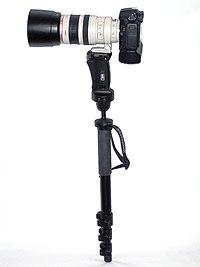
Camera and telephoto lens mounted on monopod

Monopod collapsed
A monopod, also called a unipod, is a single staff or pole used to help support cameras, video cameras, binoculars, rifles or other precision instruments in the field.
Camera and imaging use[]
The monopod allows a still camera to be held steadier, allowing the photographer to take sharp pictures at slower shutter speeds, and/or with longer focal length lenses. In the case of video, it reduces camera shake, and therefore most of the resulting small random movements. When used by itself, it eliminates camera shake in the vertical plane. When used in combination with leaning against a large object, a bipod is formed; this can also eliminate horizontal motion.
Unlike a tripod, monopods cannot support a camera independently. In the case of still cameras, this limits the shutter speed that can be used. They still allow lower shutter speeds than hand holding, and are easier to carry and use than a tripod.
Many monopods can also be used as a "chestpod," or "beltpod," meaning that the foot of the monopod (sometimes with a special adapter) can rest on the belt, waist, or chest, of the photographer. The result is that the camera is held more steadily than by hand alone (though not as steadily as when the foot is planted on the ground), and the camera/monopod is completely mobile, travelling with the photographer's movements. This is similar to a finnstick.
Monopods are usually made to fold or "telescope" quickly when not in use, allowing them to be transported and stored more easily.
Generally, in terms of mobility versus stability, if mobility increases, stability decreases as follows:
- Tripod or tablepod resting on a solid surface (most stable)
- Monopod on solid surface
- Chestpod
- Hand-held (least stable)
Monopods are often equipped with a ball swivel, allowing some freedom to pan and tilt the camera while the monopod remains relatively stationary.
Walking sticks or "trekking poles" exist that have a 1/4"-20 threaded stud on the top of the handle, usually covered by a cap when not in use, allowing them to double as a camera monopod. The user would usually need to carry a ball swivel adapter separately and mount it as needed.
Firearms[]

A Sako TRG sniper rifle on its standard factory monopod under the butt and its bipod.
A monopod can be used for firearms. They have the advantage of being light and compact, although when used in firing mode they can only be used with small firearms. They are also used as "butt spikes" as a rear support on precision rifles.
Precision optical and measuring instruments[]
When used to support a compass or transit, the monopod is referred to as a jacob staff.[1] Mounting the compass atop the jacob staff eliminates reading errors introduced by body movements, and permits the taking of more precise bearings to targets.[2] Monopods known as finnsticks are also used to steady high-power (typically, 10× or more) binoculars to permit a clear view without shake or wobble introduced by the user's hand and body movements. With the introduction of gyroscopically stabilized binoculars, the use of stabilizing supports for binoculars have declined in recent years.
See also[]
Notes[]
- ↑ Rutstrum, The Wilderness Route Finder, University of Minnesota Press (2000), ISBN 0-8166-3661-3, pp. 47-55, 64-72
- ↑ Rutstrum, pp. 47-55, 64-72
References[]
- Rutstrum, The Wilderness Route Finder, University of Minnesota Press (2000), ISBN 0-8166-3661-3
External links[]
| Wikimedia Commons has media related to Monopod. |
The original article can be found at Monopod and the edit history here.